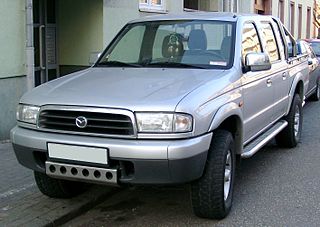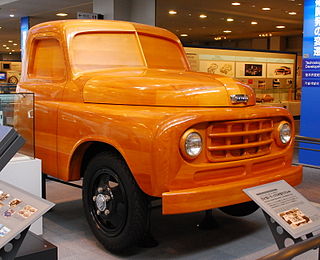
"LS engine" is the colloquial name given to the third and fourth generation small-block V8 gasoline engine used in General Motors' vehicles. The name evolved from the need to differentiate the Gen 3/Gen 4 small blocks from the original Gen 1/Gen 2 small blocks released in 1954, which are commonly referred to as "Small Block Chevrolets". The "LS" name originates from the engine RPO code of the first Gen 3 small block, the LS1, introduced in the 1997 Corvette. The term "LS engine" is used to describe any Gen 3 or Gen 4 Small Block Chevrolet, including those that do not specifically include "LS" as part of their RPO code. Sometimes referred to as an "LSx", with the lower case "x" standing in for one of the many RPO code variations of the motor, the term can cause confusion since GM now sells an aftermarket LS cylinder block named "LSX" with a capital "X". The original RPO code "LS1" is still sometimes used, if not confusingly, to describe the entire Gen 3/Gen 4 engine family.

Ford Courier is a model nameplate used by Ford since the early 1950s. First used in North America for a sedan delivery, the Courier nameplate has seen use worldwide for multiple types of vehicles. The Courier nameplate was also used by Ford for a series of compact pickup trucks and would also see use by Ford of Europe denoting a Fiesta-based panel van. Ford Brazil used the nameplate for a Fiesta-based coupe utility pickup marketed across Latin America.

Power Stroke is the name used by a family of diesel engines for trucks produced by Ford Motor Company and Navistar International for Ford products since 1994. Along with its use in the Ford F-Series, applications include the Ford E-Series, Ford Excursion, and Ford LCF commercial truck. The name was also used for a diesel engine used in South American production of the Ford Ranger.

In automotive engineering a multi-valve or multivalve engine is one where each cylinder has more than two valves. A multi-valve engine has better breathing and may be able to operate at higher revolutions per minute (RPM) than a two-valve engine, delivering more power.

The Mazda B series is a series of pickup trucks that was manufactured by Mazda. Produced across five generations from 1961 to 2006, the model line began life primarily as a commercial vehicle, slotted above a kei truck in size. Through its production, Mazda used engine displacement to determine model designations; a B1500 was fitted with a 1.5 L engine and a B2600, a 2.6 L engine.

The Nissan J series are straight-4 and straight-6 gasoline internal combustion engines produced by Nissan in the 1960s through the 1980s. It is similar to the BMC B-Series engine that was built in Japan under licence as the Nissan 1H before being de-stroked to become the 1.0 L Nissan C and 1.2 L Nissan E engines, but wasn't a direct copy.

General Motors introduced a line of Diesel V8 engines for their C/K pickup trucks in 1982. This engine family was produced by GM through 2000, when it was replaced by the new Duramax line. AM General's subsidiary General Engine Products (GEP) still produces a military variant of this engine for the HMMWV.

The Toyota UR engine family is a 32-valve dual overhead camshaft V8 piston engine series which was first introduced in 2006, as the UZ series it replaced began phasing out. Production started with the 1UR-FSE engine with D4-S direct injection for the 2007 Lexus LS. The series launched with a die-cast aluminum engine block, aluminum heads, and magnesium cylinder head covers. All UR engines feature variable valve timing for both intake and exhaust cams or Dual VVT-i. Timing chains are used to drive the camshafts. The UR engine has been produced in 4.6, 5.0, and 5.7-liter displacement versions.

The Toyota Dyna is a light to medium-duty cab over truck for commercial use. In the Japanese market, the Dyna is sold alongside its twin called the Toyoace. The Toyoace was a renaming of the Toyopet SKB Truck as a result of a 1956 public competition with 200,000 entries. "Dyna" is short for dynamic.
The Family Ⅱ is a straight-4 piston engine that was originally developed by Opel in the 1970s, debuting in 1979. Available in a wide range of cubic capacities ranging from 1598 to 2405cc, it simultaneously replaced the Opel OHV, Opel CIH and Vauxhall Slant-4 engines, and was GM Europe's core powerplant design for much of the 1980s.

The Isuzu Elf is a medium duty truck produced by Isuzu since 1959. Outside Japan it is known as N series and Q Series. The range was originally mainly available in Japan and other Asian countries. Australia was another important market for the Elf and N series – to the extent that it was manufactured there from the 1970s using many local components. Since the early 1980s, it has also been sold and built in the United States, and also as the Isuzu N-Series. Only North America receives the wide-cab version.

The Isuzu Faster is a pickup truck that was manufactured and marketed by Isuzu between 1972 and 2002 over three generations. The Faster was succeeded worldwide by Isuzu D-Max, except in North America.
The Toyota B engine family was a series of inline-four diesel engines.
The Toyota H engine is a successor to the older D series engines. The engine was first produced in 1967 but did not reach road cars till 1972, it was then replaced by the 2H engine and the 12H-T turbo engine. It was succeeded by the more advanced SOHC HZ series engine.
The Type A engine was a straight-six engine produced from 1935 through 1947 by Toyota.

The Toyota NR engine family is a series of small inline four piston engines designed and manufactured by Toyota, with capacities between 1.2 and 1.5 litres.

The Toyota BX is a 4,000 kg truck built by Toyota from 1951. It is 3.8 metres (12 ft) long, and has a close resemblance to Ford's 1948 trucks. The engines owed much to Chevrolet's inline-sixes of the period. The BX replaced the BM truck, which was introduced in 1947. Compared to the BM, the BX was considerably easier to build and the cabin could seat three rather than two.
The Toyota FA and BA were heavy duty trucks introduced in February 1954. They were facelifted versions of the earlier BX/FX trucks, retaining those trucks Type B and Type F six-cylinder petrol engines. The first letter in the model name indicates the engine family fitted; in 1957 the Type D diesel engine was introduced in a model known as the DA. The second letter indicated the size of the truck, with shorter medium duty versions being coded BC/FC/DC. A second letter "B" was used on bus versions of this chassis. A second generation FA/DA was introduced in 1964 and was built in Japan until 1980, when Hino replaced Toyota's heavier truck lines entirely. The DA, however, was also built in numerous other countries and manufacture continued into the first decade of the 21st century.












